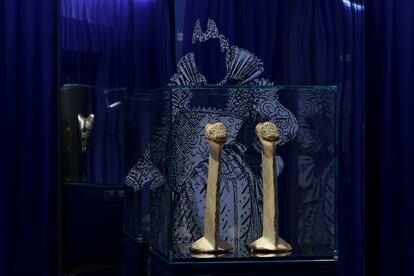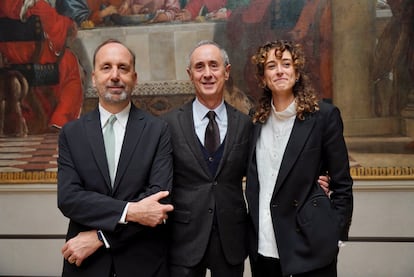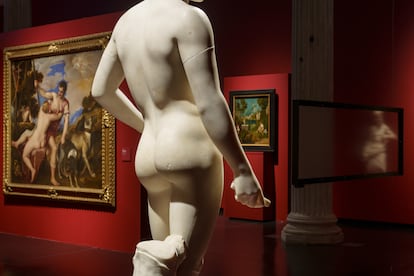Women of dairy skins, whose meats explode from sensuality, could only have been imagined by Venetian artists, authors of a new type of carnal and erotic painting: they invented young, naked females, lying in meadows typical of the vennet. These adopted, helpless bodies, suddenly became a very popular pictorial theme and, as expected, object of desire for spectators: they inspired the first pornographic book.
The exhibition Modern bodies, the construction of the body in the Venice of the Renaissance: Leonardo, Miguel Ángel, Durero, Giorgioneopen in the Gallery of the Venice Academy until July 27, explores, through an unpublished and rigorous journey, the way in which the human body went from being conceived only as a field of investigation to become something ambicious and even means of self -expression. Sala after living room that the Venetian Renaissance marked a break: the body ceased to be a biological reality to become a cultural construction, an element shaped by science, art and social conventions.
In the dawn of the 16th century, Venice was a cosmopolitan city, world capital of the printing press and the Maritime Republic. A few kilometers, in Padua there was the first anatomical theater. There the barber sectioned the body; Then, doctor Andreas Vesalio explored his interior. Vesalio became famous, among other things, for the book Body factoryprinted in Venice in 1543. That was how in the Renaissance an alliance between scientists and artists arose to carry out the first studies of anatomy. But later, “the Venetians transformed the anatomical drawings into sensual representations of male and female meat. And, finally, they built their own identity,” says Guido Beltramini, who has curated the exhibition together with Francesca Burgo and Giulio Manieri Elia, director of the museum. They have spent four years.
Beltramin walks slowly. It is located in the room that hosts the huge fabric The dinner at Levi’s house, by Pablo Veronés; He goes to the pavilion he welcomes Modern bodies. The commissioner warns: “We are going to find some short circuits.” Such an indication is equivalent to saying that, on the walk through the sample, dialogues between similar works will be seen, either in chronology or thematically, or because they are close authors in time and space, or because they are versions of the same painting, sculpture or drawing.
The first short circuit star The man of vitruvio by Leonardo da Vinci and the irreverent Naked body self -portrait by Alberto Durero. Leonardo drew the ideal proportions of a man in leathers, in two superimposed positions. To do this, he made empirical measures of the body of hundreds of young people in flesh and blood and even animals. “Starting from the extreme variety of bodies, Leonardo wanted to reach the essential: what is the human being, where is his harmony, what are his measures and what is the algorithm with which nature created us,” says Beltramini.

The commissioner stops in front of Durero’s self -portrait. It approaches to where security alarms are allowed. As if it were the first time, he runs it with his eyes from top to bottom. And he explains: “This is the first Renaissance nude of a real man. He is a radical self -portrait of an adult, robust, naked man, who uses his own body to investigate and reflect. The center of attention is found in the head and in the genitals.” At almost 40 years old, on one of his two trips to Venice, Durero reformulated Leonardo’s theory of proportions. For the German artist, no one is perfect and each one has a different form of perfection. As the Commissioner Francesca Burgo declares: “Durero becomes aware of the fact that there is no absolute beauty, but different forms of relative beauty … thin/fat, soft/robust, strong/weak, white/black.”
The exhibition claims the female nude as an inheritance of Renaissance Venetian painting. The woman offers passively to be observed, in symbiosis with the environment that shelters her, becoming herself in part of the landscape. Here are to testiminate La Desnuda de Bernardino Lucinio, preserved in the gallery of the Uffizi of Florence; the Sleeping naked from Girolamo de Treviso, from the Borghese gallows of Rome, and the protagonist of The storm de Giorgione, owned by the Gallery of the Academy of Venice.
Occupies a central placement Venus and Adonis, From Tiziano Vencellio, one of the most famous works of the painter of potatoes and kings; Despite not showing the sexual act, it seemed to its contemporary spectators the most erotic. Tiziano’s virtuous hand made various copies, among which is the exhibition, which belongs to a private collection. One of the versions can be seen in the Prado National Museum. The goddess’s position puts Tiziano on the top of the teachers, unique in molding the bodies through light and color. To create it, the artist was inspired by the Roman baskiliers Ara Grimanipreserved in the Archaeological Museum of Venice. Another well -achieved short circuit. On the other hand, in the section dedicated to male nude, the body of desire becomes lyrical, sufficient and sublime, including images of saints, heroes and ancient portraits.

And when nudity becomes an image, it becomes object. “Every time a new means of communication appears in history, the erotic imagination explodes. It happened with photography, cinema and now with the Internet,” says Beltrmoni. The commissioner is two steps from the red velvet curtains, after which a pirate copy of the first erotic book can be seen, Lustful sonnets, of Pietro Aretino, printed in Venice in 1532. All the originals were burned. The spicy booklet, with “obscene figures and in libidinous acts,” read in the Plaza de San Marcos.
This tit is mine!
How not to stop in front of one of the star paintings of the exhibition. Two men and a woman, elegant, youth appear immortalized by Tiziano. She rests her head on the knight’s back to the left, he hugs her and puts her hand into the bosom. The work is called Portrait of husbands with testimony (Windsor, Royal Collection). For years he was known as Doctor who examines the woman with the husband who looks. “It does not seem to me that the doctor is examining it,” says Commissioner Beltramini. Release a laugh and add: “The alleged doctor is her husband.”
The gesture of touching the female chest represented a very common marriage rite in the Venetian rebirth. It has a precise symbolic validity: the taking of possession of the young wife, while the man in the background represents the ring and, at the same time, testimony of the union. However, the teta’s touker is over when the Council of Trent imposed, in 1553, the ecclesiastical ceremony. It is confirmed by a marriage dispute of 1552, in which the husband, Francesco de Orlandi, claims his rights over his fiancee, Clara Marcello, for “having set his hand on his chest and having touched his breasts” in the presence of witnesses.

The appearance counts
The women and men of the Renaissance began to conceive their identity as a cultural issue. The objects gathered in the last room, including combs, inks for dyeing blond hair, white face powders, platform shoes of up to 50 centimeters, underpants – linked by them to dress and behave like them -, mechanical prostheses to overcome amputations or war wounds, constitute examples of the construction of the person in the venection of the sixteenth century. “The bodies of modern rebirth are allowed to change, transform, become something different from themselves. It is not about sustaining a fiction, but about becoming more authentically one: for Erasmus it does not matter how it is born, but how one is built throughout life,” Beltrami ditch.
These bodies from a distant past five centuries, today as before, continue to question us about the future of humanity, sexuality, identity, beauty, appearance and old age. The old woman De Giorgione (1502), with his face furrowed by wrinkles, reminds us of the irremediable passage of time.

